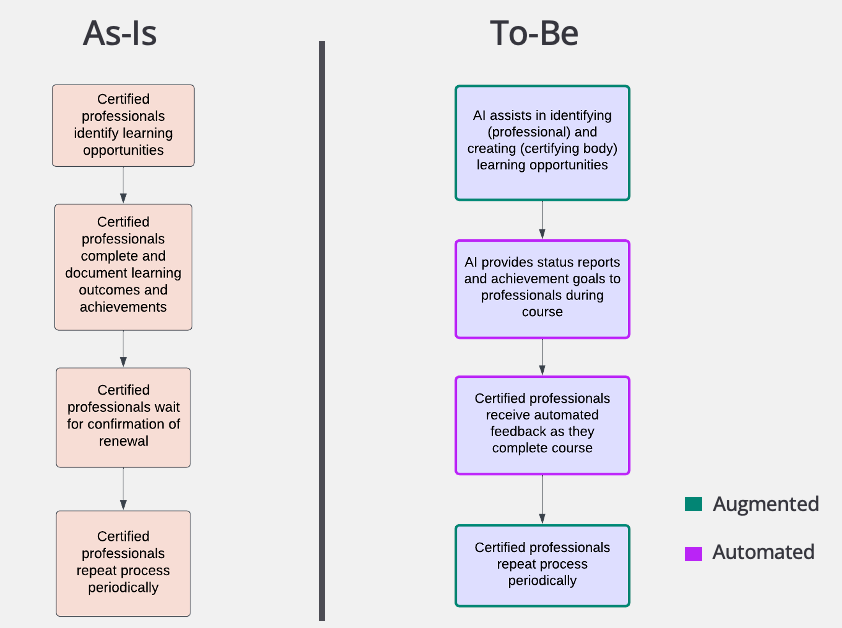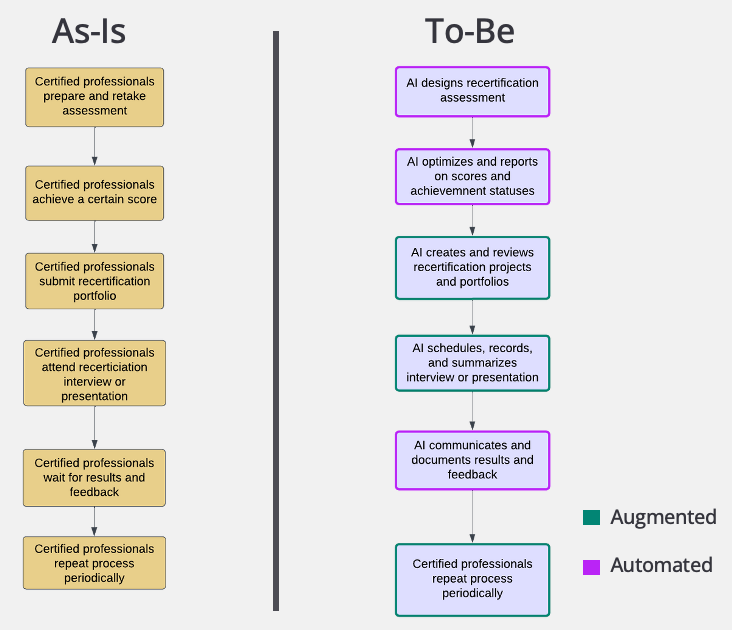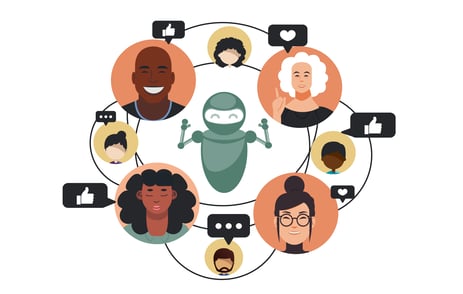This series is dedicated to exploring the role of AI augmentation in revolutionizing the certification process. AI augmentation, which aims to enhance and complement human capabilities rather than replace them, holds the promise of streamlining and optimizing various facets of certification. From automating data collection and validation to improving decision-making and communication, AI augmentation can significantly reduce bottlenecks, errors, and delays, leading to a more efficient and effective certification journey. Keep in mind, processes vary considerably from one association to the next, so this is just an example of the process to draw inspiration from.
>>> Read more: The AI Augmented Certification Process: Part 1
>>> Read more: The AI Augmented Certification Process: Part 2
Welcome to Part 3 of Sidecar’s series on the transformative potential of AI augmentation in the certification process. In the last part of this series, we explored how AI can revolutionize the requirements validation and committee review and approval processes in certification. So far, we’ve seen the ways in which the traditionally labor-intensive stages of manually checking materials, reviewing additional content, conducting interviews, and overall manual processing are ripe for transformation. By employing AI, tasks such as designing and delivering assessments, analyzing and optimizing scores, creating and reviewing portfolios, conducting interviews, and accelerating results can be significantly improved. In this article, we will complete the certification process by discussing the two final stages- the continuing education process and the recertification process. Let’s dive in…
The Continuing Education Process
In many instances, continuing education is required in order to maintain a certification. Continuing Education (often referred to as CE/CEU generically, or with terms like CLE and CME in the legal and medical fields), where the certified professionals maintain and update their competence and proficiency in the domain of the certification, and meet the minimum requirements for the renewal of the certification. The continuing education process can also vary depending on the type, level, and scope of the certification, as well as the policies and procedures of the certifying body. However, some common steps and challenges are:
- Must identify and pursue relevant learning opportunities (e.g., courses, workshops, webinars).
- Complete and document learning outcomes and achievements (e.g., certificates, credits).
- Submit and verify outcomes to the certifying body and pay the renewal fee; can be expensive and non-refundable.
- Wait for confirmation of renewal; can be lengthy and lack transparency.
- Repeat the continuing education process periodically; can be inflexible and restrictive.
The continuing education process can be improved by:
- Using AI to design and deliver the learning opportunities and activities.
- Applications:
- Using ML to generate and adapt the content and the assessment.
- Using LLMs to evaluate and grade the performance.
- Applications:
- Using AI to analyze and optimize the learning outcomes and achievements.
- Applications:
- Using ML to calibrate and normalize the outcomes.
- Using LLMs to provide and justify the feedback.
- Applications:
- Using AI to verify and validate the learning outcomes and achievements.
- Applications:
- Using ML to match the outcomes with the requirements.
- Using blockchain to ensure the authenticity and security of the documents.
- Applications:
- Using AI to reduce and optimize the renewal fee.
- Applications:
- Using ML to analyze the cost and value of the certification.
- Using smart contracts to automate the payment and refund processes.
- Applications:
- Using AI to enhance and update the communication and feedback of the renewal.
- Applications:
- Using LLMs to generate and send notifications and reminders.
- Using chatbots to answer queries and provide guidance.
- Applications:
- Using AI to extend and customize the renewal period.
- Applications:
- Using ML to predict the demand and supply of the certification.
- Using recommender systems to suggest the best time and mode of renewal.
- Applications:

The Recertification Process
In some but not all cases, certifying bodies require a comprehensive recertification process on an on-going basis. This is most often the case in technical trades where the overabundance of new information and skills warrants a fresh certification from time to time, as well as in high stakes professions like medical. In many other professions, once an individual is certified they can maintain the certification in good standing by completing their required annual/bi-annual CEUs. In the case where a recertification process is required, previously certified professionals demonstrate their continued competence and proficiency in the domain of the certification, and meet the minimum requirements for the revalidation of the certification. The recertification process can also vary depending on the type, level, and scope of the certification, as well as the policies and procedures of the certifying body. However, some common steps and challenges are:
- Prepare for and take a recertification exam or assessment; may vary from the initial exam.
- Achieve a required score or grade.
- Submit a recertification portfolio or project; may vary from the initial submission.
- Attend a recertification interview or presentation.
- Wait for recertification results and feedback; process can be lengthy and lack transparency.
- Repeat the recertification process periodically; can be inflexible and restrictive.
The recertification process can be improved by:
- Using AI to design and deliver the recertification examination or assessment.
- Applications:
- Using ML to generate and adapt the questions and answers.
- Using LLMs to evaluate and grade the responses.
- Applications:
- Using AI to analyze and optimize the recertification score or grade.
- Applications:
- Using such as by using ML to calibrate and normalize the scores.
- Using LLMs to provide and justify the feedback.
- Applications:
- Using AI to create and review the recertification portfolio or project.
- Applications:
- Using ML to generate and customize the tasks and the criteria.
- Using LLMs to evaluate and comment on the work.
- Applications:
- Using AI to conduct and record the recertification interview or presentation.
- Applications:
- Using LLMs to generate and ask the questions and the feedback.
- Using computer vision to analyze and capture the expressions and the gestures.
- Applications:
- Using AI to accelerate and update the results and the feedback of the recertification.
- Applications:
- Using ML to automate and streamline the scoring and the reporting.
- Using LLMs to generate and send notifications and reminders.
- Applications:
- Using AI to extend and customize the recertification period.
- Applications:
- Using ML to predict the demand and supply of the certification.
- Using recommender systems to suggest the best time and mode of recertification.
- Applications:

Impact of AI on Stages 5 & 6 of the Certification Process
AI significantly streamlines the recertification process by automating administrative tasks, scheduling exams, and sending reminders, which reduces the burden on professionals and certifying bodies. It efficiently processes submissions, providing immediate feedback on performance, allowing for timely planning and adjustments. By dynamically adjusting recertification criteria based on industry trends and past performance, AI ensures the relevance and up-to-date competencies of professionals. It personalizes educational content, tailoring topics, pacing, and learning styles to meet individual development needs. Automated systems simplify tracking and validating continuing education credits, making course recognition more straightforward. Additionally, AI's predictive capabilities analyze trends and performance data to forecast future educational needs, enabling proactive curriculum development and ensuring professionals stay ahead in their fields.
Elevate Your Association's Processes with AI
AI emerges as a transformative force in the certification landscape, reducing manual workload and introducing a new level of efficiency and personalization. From tailoring continuing education to streamlining recertification, AI's integration promises a more adaptable, precise, and user-focused approach. This technological evolution offers a clear path forward for certifying bodies and professionals alike, ensuring that the pursuit of excellence in certification is as dynamic and forward-thinking as the industries it serves. As the journey towards AI-augmented certification processes continues, it beckons a future where growth and innovation go hand in hand.
This article concludes our 3 part series on AI-enhanced certification. Looking for more ways to deploy AI within your organization? Check out Sidecar’s AI Learning Hub for Association Teams, where you’ll gain insight and understanding on practical, everyday AI enhancements for your team.

April 8, 2024



